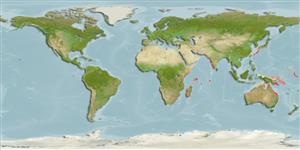Environment: milieu / climate zone / depth range / distribution range
Écologie
marin récifal. Tropical
Southeast Atlantic: East London to Port Alfred, South Africa. Western Indian Ocean: Seychelles (Ref. 5465). Western Central Pacific (Ref. 10275).
Taille / Poids / Âge
Maturity: Lm ? range ? - ? cm
Max length : 7.3 cm TL mâle / non sexé; (Ref. 5465)
Description synthétique
Clés d'identification | Morphologie | Morphométrie
Épines dorsales (Total) : 0; Rayons mous dorsaux (Total) : 50 - 51; Épines anales: 0; Rayons mous anaux: 23 - 24. Mouth large; lower jaw strongly projecting; upper jaw protrusible (Ref. 10275). Body pale olive above, silvery white below; fine black dots on dorsal and anal fins (Ref. 5465).
Occurs in sandy areas (Ref. 10275). Rare species (Ref. 5465).
Life cycle and mating behavior
Maturities | Reproduction | Spawnings | Egg(s) | Fecundities | Larves
Collette, B.B., 2001. Ammodytidae. Sandlances. p. 3518. In K.E. Carpenter and V. Niem (eds.) FAO species identification guide for fishery purposes. The living marine resources of the Western Central Pacific. Vol. 6. Bony fishes part 4 (Labridae to Latimeriidae), estuarine crocodiles. FAO, Rome. (Ref. 10275)
Statut dans la liste rouge de l'IUCN (Ref. 130435)
Menace pour l'homme
Harmless
Utilisations par l'homme
Outils
Articles particuliers
Télécharger en XML
Sources Internet
Estimates based on models
Preferred temperature (Ref.
123201): 21.6 - 29, mean 27.1 °C (based on 1021 cells).
Phylogenetic diversity index (Ref.
82804): PD
50 = 0.5010 [Uniqueness, from 0.5 = low to 2.0 = high].
Bayesian length-weight: a=0.00324 (0.00148 - 0.00706), b=3.10 (2.91 - 3.29), in cm total length, based on LWR estimates for this (Sub)family-body shape (Ref.
93245).
Niveau trophique (Ref.
69278): 3.1 ±0.4 se; based on size and trophs of closest relatives
Résilience (Ref.
120179): Haut, temps minimum de doublement de population inférieur à 15 mois (Preliminary K or Fecundity.).
Fishing Vulnerability (Ref.
59153): Low vulnerability (10 of 100).
